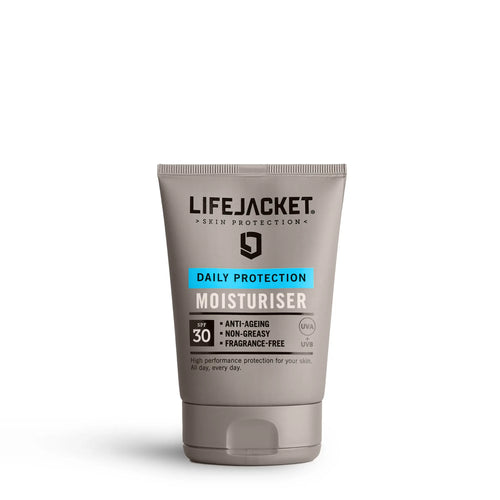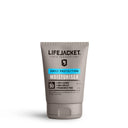Chances are, if you’re reading this – no matter your water sport of choice – you’re somebody who’s regularly outside and on the water for long periods.
With ‘blue therapy’ comes enormous enjoyment, sometimes action-packed, other times just relaxing time away from everyday life. But, being outside on the water can also wreak havoc on your skin. Variable temperatures, strong wind, high or low humidity, perspiration from exercise and extreme UV are all a recipe for skin damage, a dry skin-barrier, soreness, itchiness, redness and cracking.
So that you can enjoy being on the water to its fullest and focus on the reasons you’re there (and not the painful side-effects), here are five tips for skin safety on the water, including why we think they’re important.
1. Be UV-aware
External aggressors – as we call them – like harsh, cold weather, dry or hot air, ultraviolet light, pollution, smoke and stress attack your skin every single dayThese aggressors cause skin damage. Damage could be anything on a spectrum from wrinkles, dryness, redness, itchiness or sensitivity, all the way to skin cancer (and thousands of other things in between).
Your skin is the body’s first line of defence and it needs help to repel these aggressors. For us, that comes in the form of skin protection. It isn’t skin care unless it’s skin protection.
The gorilla in the room and chief of all aggressors is ultraviolet light.
UV is responsible for 80% of premature skin ageing and 90% of melanoma skin cancers.
Here’s the important bit of science most people don’t realise. UVA in particular reaches your skin every single day and in equal measure throughout the year. It also accounts for 95% of the UV that reaches us on earth. So, as long as it’s light outside, UVA hits your skin – even through cloud and glass.
UVA penetrates the deeper layers of the skin meaning you can’t see the damage. It contributes to premature skin ageing and wrinkling by damaging the natural proteins under the skin’s surface. These proteins keep the skin tight and strong but, when damaged, can’t provide the same structural support.
For a long time, it was thought that UVA couldn’t cause any lasting damage other than these cosmetic changes but studies strongly suggest UVA enhances the development of skin cancers because the rays also cause DNA damage in the skin.
Given UV is ever present, the temperature outside or time of year doesn’t matter. On the water, UV hits you twice: once from the sun and again, as it bounces off the sea, river or lake and back onto you. Combined, this almost doubles your UV exposure. For this reason, water can be a harsh UV environment particularly if you’re out for several hours.
So, for any time on the water – any time of year – use a good sunscreen before heading outside on all exposed skin. We recommend a minimum of SPF 30 and the European ‘UVA’ kite mark (or UVA 4-5*). Reapply every two hours and don’t forget your lips, nose, back of the neck and ears – commonly missed spots where people often burn. No sunscreen can stay on your skin all day and protection levels will diminish if you’re getting splashed, sweating or towelling.
If you care about your health, this is a really important part of your gear.
2. Is your kit 'UPF'?
Another way to protect the skin is by wearing a physical barrier that blocks attack i.e. clothing.
But beware – not all fabrics are created equal. For example, a white cotton t-shirt is the equivalent of SPF 5 and you could feasibly experience invisible skin damage through it.
Ultraviolet Protection Factor (UPF) is to fabrics what SPF is to sunscreen. It’s a measure of how much UV protection the fabric provides.
Denim is UPF 1,700 so it’s super protective but I’m not sure we could persuade you to attack that kicker, in the middle of summer, wearing your favourite 501s…
Look out for UPF 50+ active wear. It’s a good option if you don’t like cosmetic creams on your skin.
3. Stay moisturised
Moisturisers can do two things depending on their ingredients: form a layer to block water leaving or try and add water to the epidermis.
Use what you like and apply at least twice a day for dry skin and especially if your skin is going to take a bashing in harsh water environments. Apply straight after a bath or shower to seal in moisture while your skin is damp. Don’t forget about your hands and body – they definitely won’t say no to a daily layer of added moisture.
During the day, your moisturiser needs to contain SPF as explained earlier. If you’re shaving, leave cream or gel on your face for a few minutes before starting. Bonus points for using an evening balm/oil/moisturiser.
4. Don't forget your head and lips
It might get hot but your head’s a sitting duck under strong sun. That’s even more true to all the men out there who are bald or have a close cut on top. Depending on which water sport you do, consider finding a hat that stays on. There are breathable, lightweight, UPF 50+ variants out there. It’s a whole lot better than a sunburnt head or sun stroke.
And don’t forget your lips even if they don’t normally need any special attention. Lips don’t produce sebum so can quickly become dry. They also burn more easily than other areas of skin. Keep an SPF lip balm in your wetsuit or pack for both UV protection and moisture. Reapply constantly throughout the day.
5. Protect your eyes
For the same reason it’s ideal to protect your skin from UV every day, we should probably all wear sunglasses more often than we think.
Protecting your eyes against sunlight and glare from water is really important for your eye health. UV levels can be high even on a cloudy day and overexposure can lead to painful inflammation, known as ‘snow blindness’. It can also increase the likelihood of developing cataracts.
Sunglasses with UV400 protection (or which have the CE kite mark) and polarized lenses are a critical piece of kit. Low quality lenses can cause more harm than good.
6. Drink up
Avoid heat stroke and maintain cellular moisture from the inside out by drinking up. Especially if you’re active, outside and sweating. It’s quite common not to drink enough water: try and target 2-4 litres a day.






